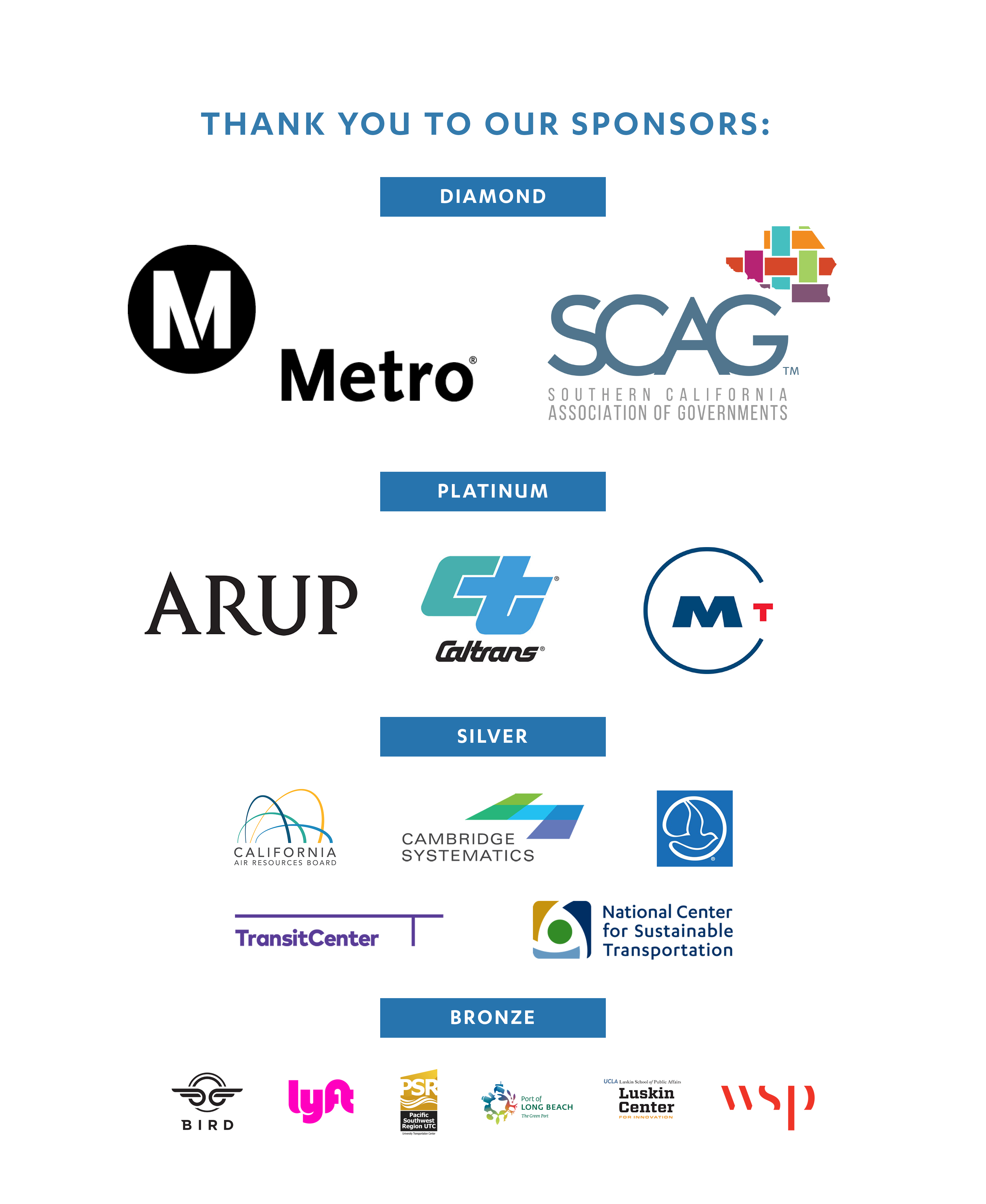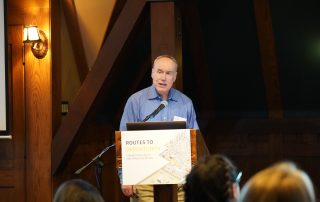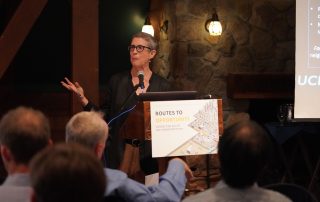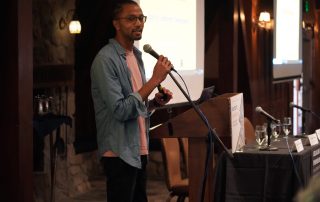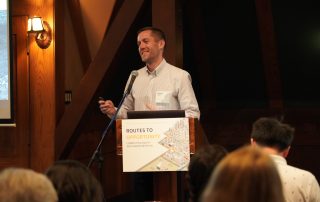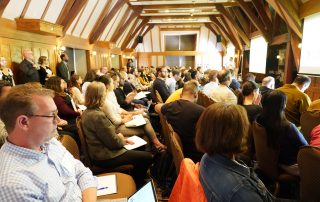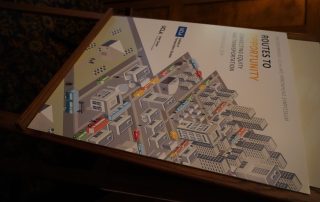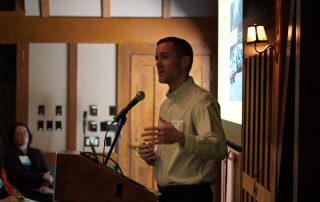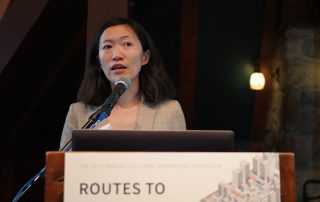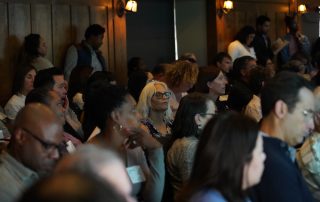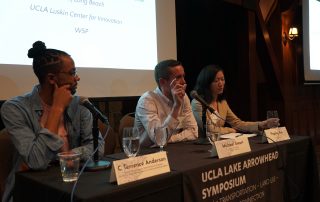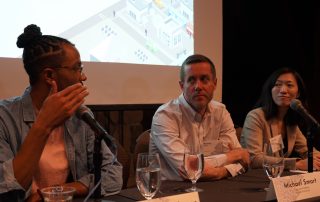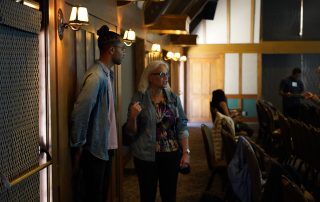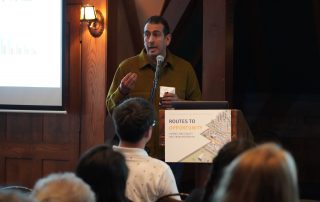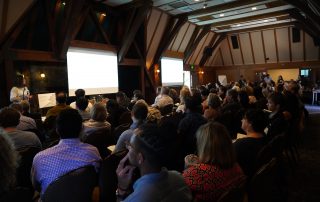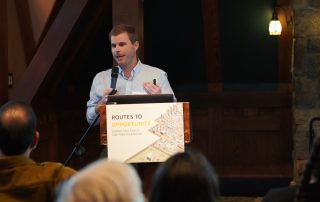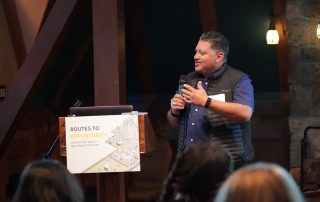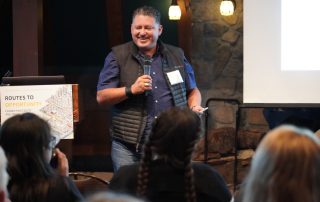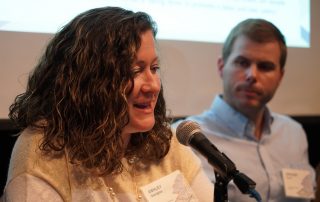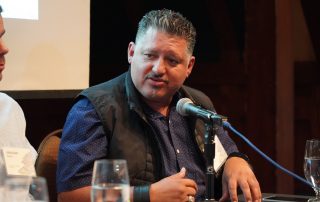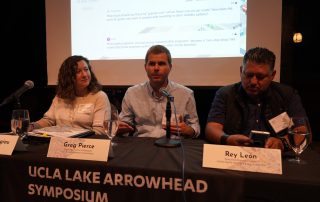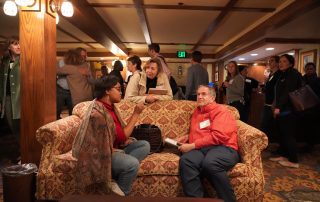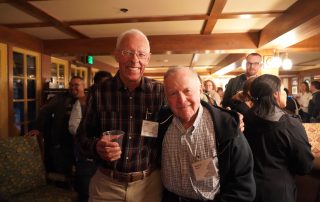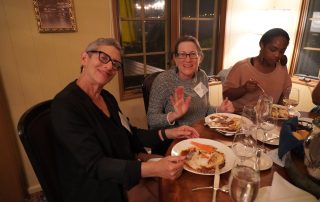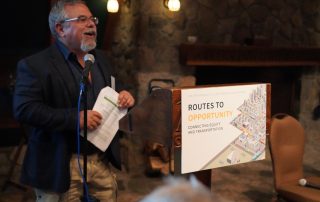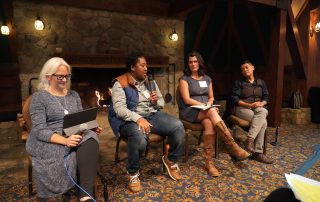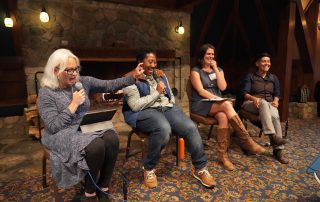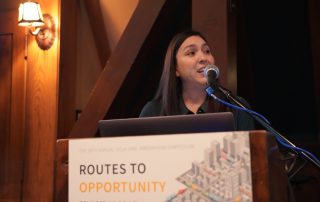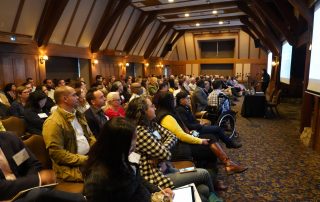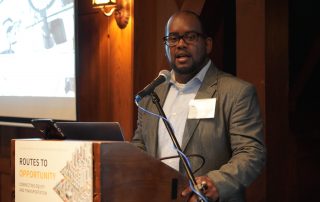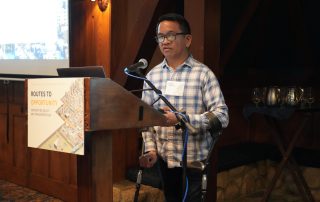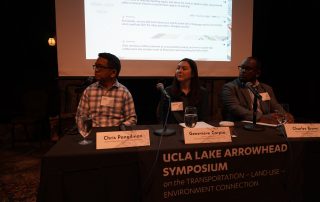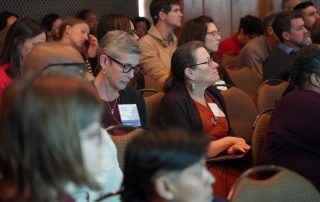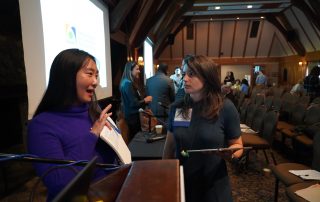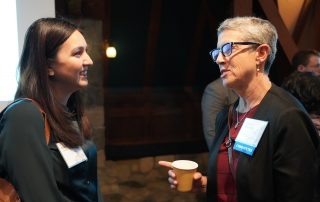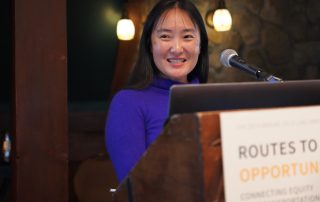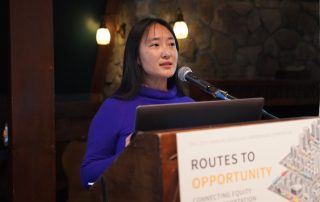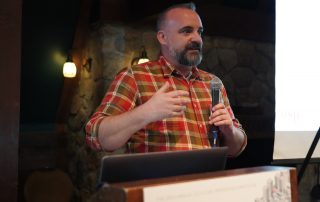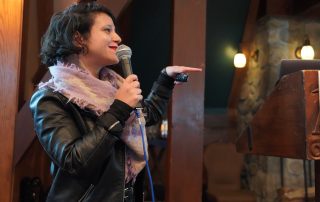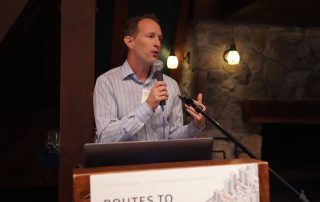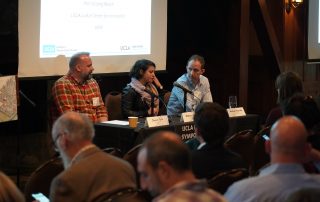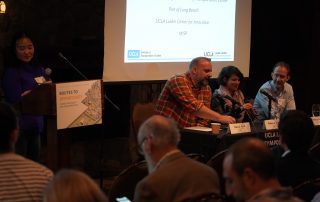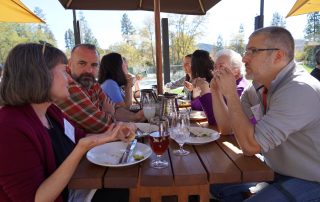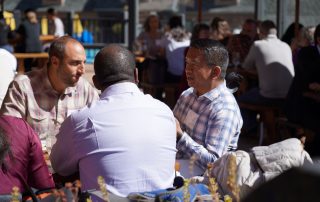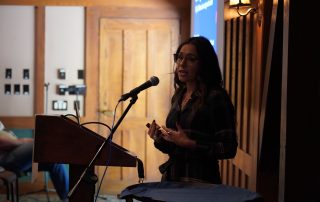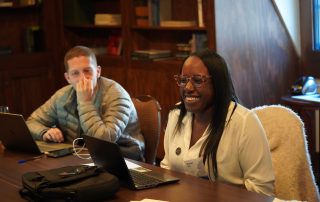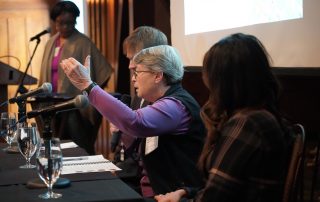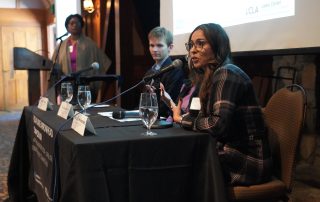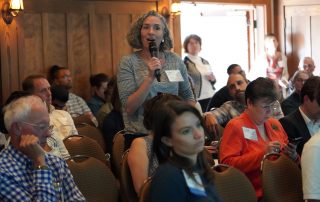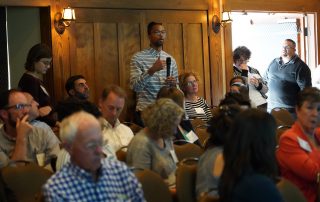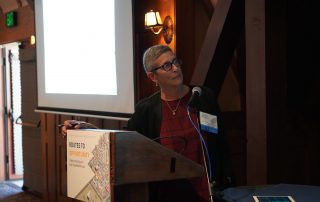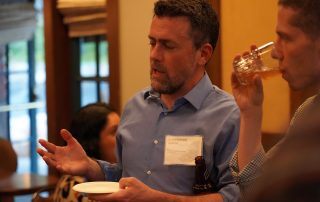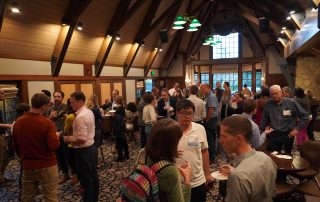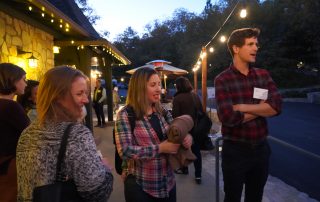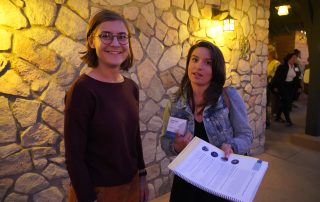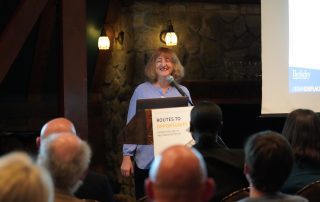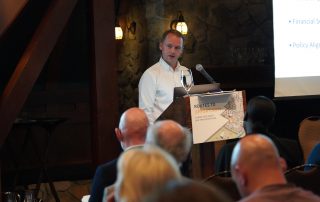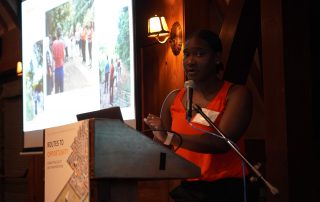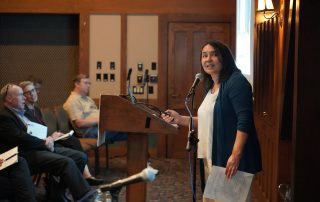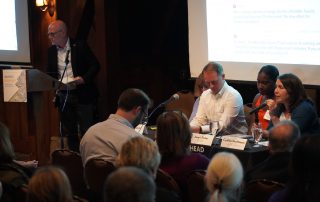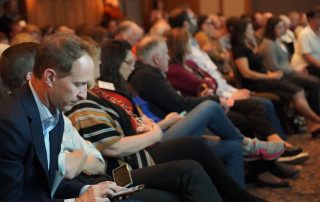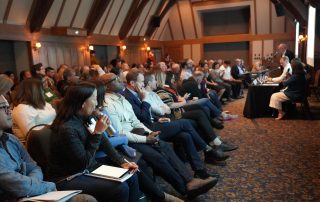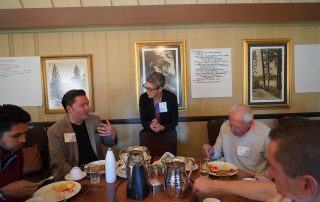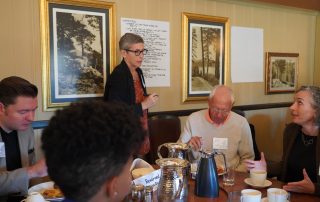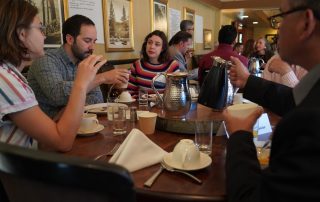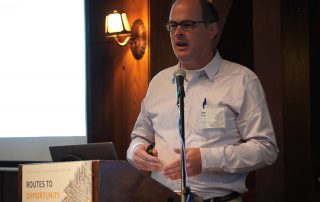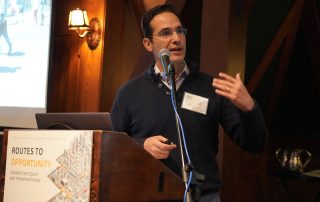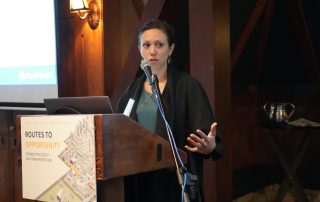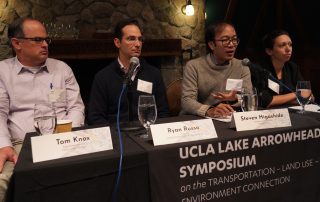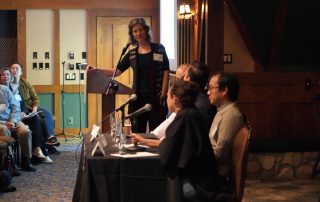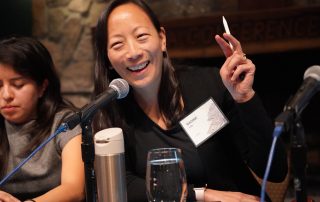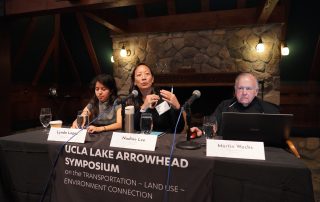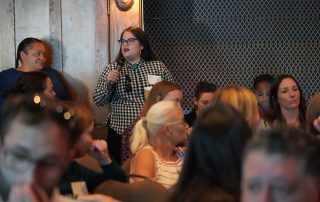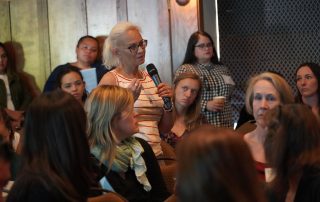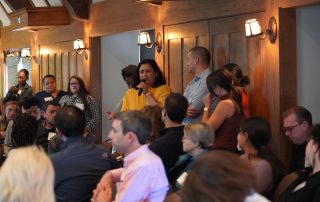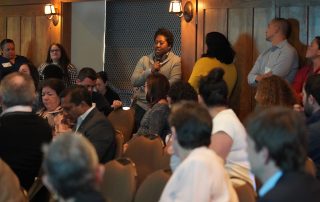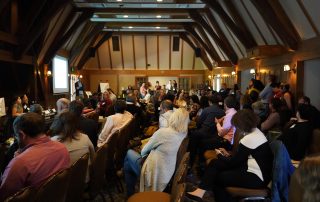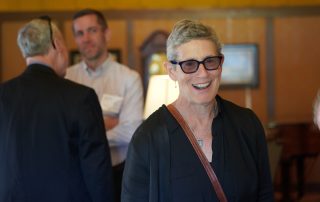A Focus on Equity
Session Wrap-ups
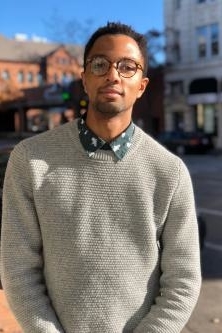 |
 |
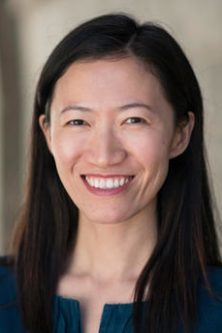 |
|
| C Terrence Anderson Director of Community-Based Research Programs at University of Minnesota Center for Urban and Regional Affairs |
Michael Smart Associate Professor at Rutgers University |
Yingling Fan Professor at University of Minnesota |
Transportation as a Means for Opportunity
More than 180 transportation policymakers, planners, and advocates gathered Oct. 20-22 for the 29th annual UCLA Lake Arrowhead Symposium — Routes to Opportunity: Connecting Transportation and Equity. This year’s event examined how transportation and land use approaches can advance policies and programs that center social equity and improve access to opportunity for people and communities.
The event kicked off with a discussion on the relationships between transportation and employment opportunities, especially how these relationships vary by mode, race, class, and location.
The session was moderated by Evelyn Blumenberg, director of the UCLA Lewis Center for Regional Policy Studies and professor of urban planning at the UCLA Luskin School of Public Affairs, and included presentations by C Terrence Anderson, director of community-based research programs at the University of Minnesota Center for Urban and Regional Affairs; Michael Smart, associate professor from Rutgers University; and Yingling Fan, professor at the University of Minnesota.
Advancing regional equity through transportation development & community organizing
Anderson spoke about how the Twin Cities area has received positive press attention for expanding its transit and eliminating single-family zoning, but that is not the whole story. The region is becoming increasingly unaffordable. In 2014, there was no neighborhood where a black resident with a median income of $14,951 could afford rent.
As governments and transit agencies work to invest in these neighborhoods, Anderson said it’s key to acknowledge the role of transit investment in displacement and gentrification. He also discussed the need to change the narrative: Often, the problem is defined as concentrated poverty instead of concentrated areas of wealth in suburbs.
Community organizing should also be at the center of transit decision-making. The use of a racial equity framework will ensure solutions are contextualized, community-centered and commensurate with what caused the inequities, he said.
Automobility and access to opportunity
Rutgers professor Smart highlighted the economic mobility associated with access to automobiles. Having a car provides access to jobs, reliability to get to work on time and keep that job, and the ability to search for better-paying employment. Some studies have shown that a car confers about $10,000 more in yearly earnings.
Carlessness and poverty are increasingly linked, Smart said. Even when poor families get a car, many will lose it within two years. According to his research, Smart found that after losing a car 74 percent of people worked fewer hours or stopped working altogether, 81 percent went to the doctor less, and 82 percent of parents took their children to fewer places.
Is it possible to provide low-income families with cars while reducing car usage among wealthy families?
How transit investments can advance transit equity
University of Minnesota professor Fan said a key incentive to decrease personal vehicle use is a high-quality transit system. “It’s wrong to plan public transit only for those who need it,” she said. Everything from environmental impacts to quality commute time can be motivators but will need a transit system to support it.
Fan closed out the session with an analysis of how transit agencies can change mobility inequities in the future. Currently, low-income and minority households tend to have fewer transportation options and, thus, less access to opportunities. She explored how changes in investments and transit services can improve potential access to opportunities, especially for disadvantaged communities.
“Mass transit needs to be mass to be successful,” said Fan, referring to a robust system that includes multimodal options, bus-rail integrations, and supportive land-use policies.
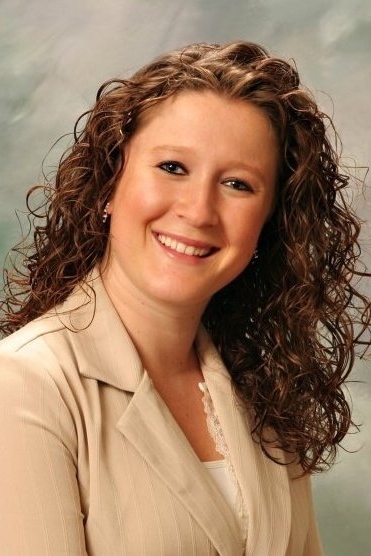 |
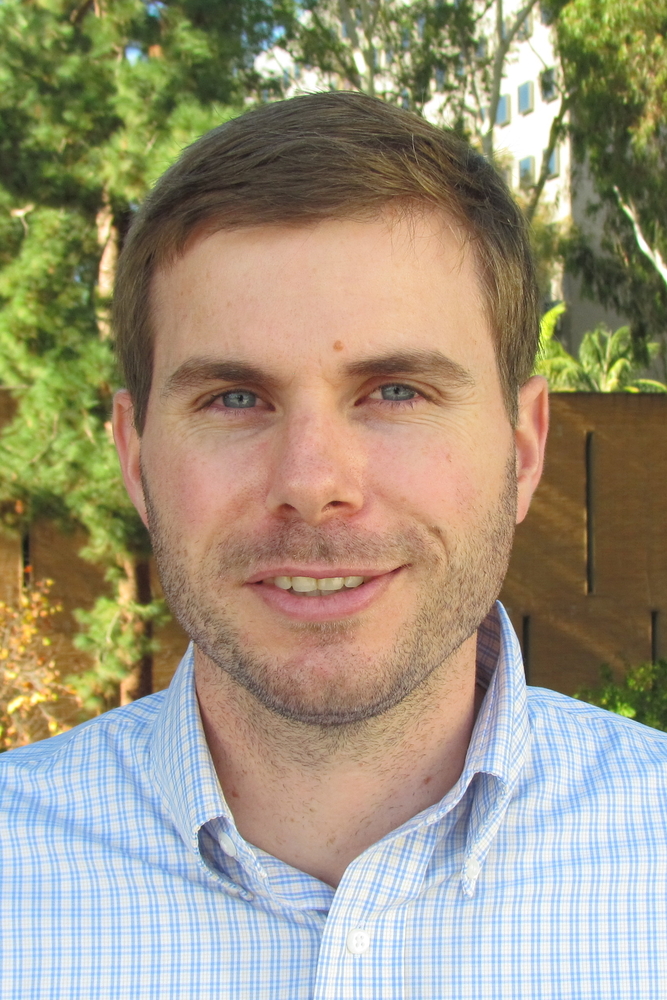 |
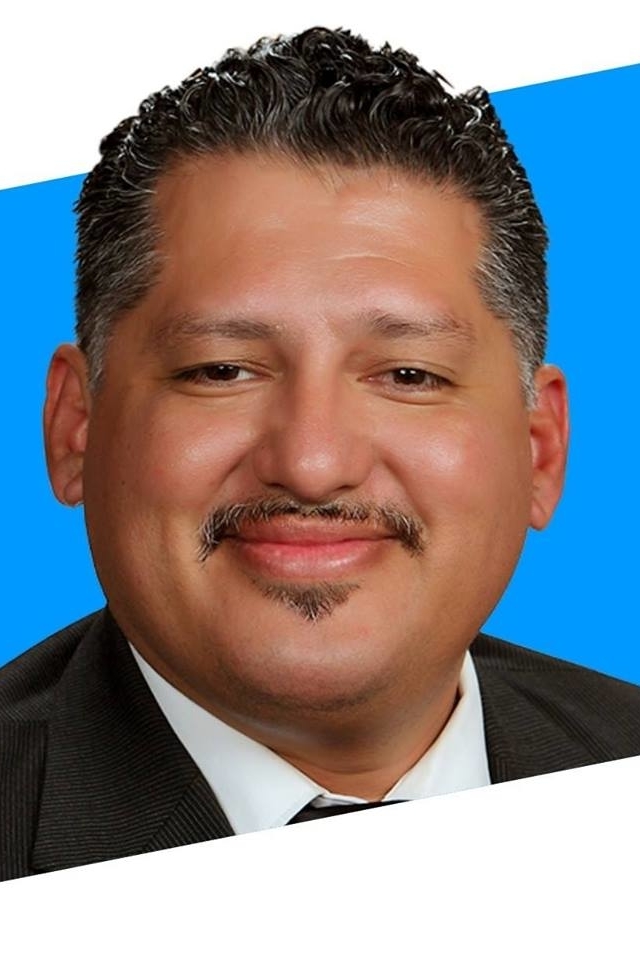 |
|
| Ashley Georgiou Staff Air Pollution Specialist at California Air Resources Board |
Greg Pierce Associate Director of Research at UCLA Luskin Center for Innovation |
Rey León Mayor of City of Huron, California |
Connecting transportation access to environmentally just outcomes
More than 180 transportation policymakers, planners, analysts, and advocates gathered Oct. 20-22 for the 29th annual UCLA Lake Arrowhead Symposium, Routes to Opportunity: Connecting Transportation and Equity. This year’s conference examined how transportation and land use approaches can advance policies and programs that center social equity and improve access to opportunity for people and communities.
The event’s second session explored how cities and advocates can move toward active participation in a climate justice economy by mitigating the environmental and public health consequences of transportation infrastructure, particularly as they relate to vulnerable communities.
The session was moderated by Marcel Porras, chief sustainability officer for the Los Angeles Department of Transportation, and included presentations by Ashley Georgiou, air pollution specialist at the California Air Resources Board; Greg Pierce, associate director of research at the UCLA Luskin Center for Innovation; and Rey León, mayor of Huron, California, and founder and executive director of the San Joaquin Valley Latino Environmental and Advancement Policy (Valley LEAP).
Lowering emissions while increasing access to transportation
While the Air Resources Board oversees air quality on a regional basis, the board must balance how its programs prioritize the short-term needs of high-need communities by coordinating with local partners and air districts. Statewide investments are helping jumpstart transformation of the transportation sector, Georgiou said, by providing cleaner alternatives that also help access essential services.
In the most recent year’s proposed funding, CARB set aside $533 million in clean transportation investments, including $485 for low-carbon options like vehicle purchase incentives, clean transportation equity investments.
Georgiou said that CARB relies on partnerships to gain a broader understanding of each community’s needs and has instituted processes to build from lessons learned, such as requiring a transportation needs assessment as part of projects.
Measuring California’s climate investments for low-income households
As key oversight and policy bodies such as the Air Resources Board enact programs aiming to improve air quality and accelerate clean climate justice investments, it is essential to measure and evaluate these programs to inform future ones. Pierce explained the key goals for these programs, and how they factor in impacts on disadvantaged communities, noting that previous programs that supported car ownership did not combat the environmental impacts. (Low-income households tend to purchase older cars that pollute more and are less likely to pass smog tests or be registered.)
Pierce said the evaluation of these programs suggests that offering rebates increases clean vehicle purchases up to 70 percent and that CARB’s new guaranteed interest-rate financing program could be more cost-effective than purchase incentives alone.
Transformative neighborhood investments
The San Joaquin Valley has some of the nation’s worst air quality, falling short of federal standards for both smog and particulate pollution, resulting in respiratory problems for many of its residents. Residents of Huron — an agricultural community outside of Fresno — drive one hour, or four hours via public transit, to reach the nearest hospital.
Mayor León launched an initiative that invests in transportation access for residents while also improving much-needed access to healthcare. The Green Raiteros program, a nonprofit ridesharing partnership, builds on an existing rural tradition of volunteer raiteros offering car trips to riders while expanding access to electric vehicles. León wants Huron to be the greenest farmworker community in the country and today, the city has the most electric chargers per capita in the nation.
 |
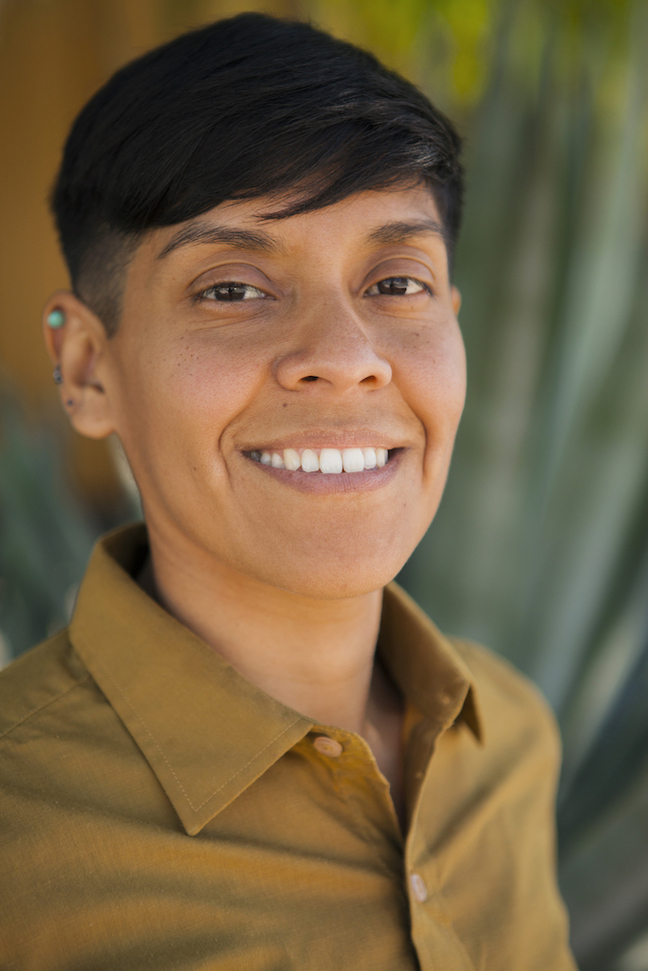 |
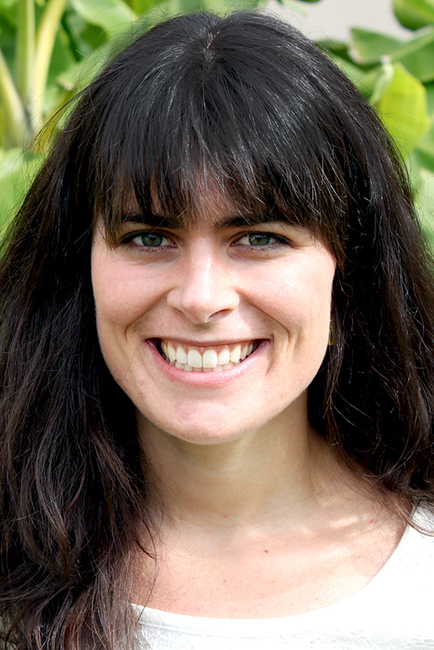 |
|
| Tamika L. Butler, Esq. Director of Planning at Toole Design Group |
Río Oxas Building Power Director at People for Mobility Justice |
Vanessa Carter Senior Data Analyst at USC Program for Environmental and Regional Equity |
Beyond public participation: Access to power and decision-making
More than 180 transportation policymakers, planners, and advocates gathered Oct. 20-22 for the 29th annual UCLA Lake Arrowhead Symposium, Routes to Opportunity: Connecting Transportation and Equity. This year’s conference examined how transportation and land use approaches can advance policies and programs that center social equity and improve access to opportunity for people and communities.
The final session of the symposium’s first day covered the public participation process in transportation decision-making and, chiefly, how the standard models of participation govern access to power and the ability to shape planning outcomes.
Therese McMillan, executive director of the Metropolitan Transportation Commission, moderated the session, which included discussions with Tamika Butler, Esq., director of planning of Toole Design Group; Río Oxas, the building power director of People for Mobility Justice; and Vanessa Carter, senior data analyst at the USC Program for Environmental and Regional Equity.
From outreach to engagement
When cities plan new transportation projects, standard “outreach” often only consists of informing communities about a change, rather than involving them in the early stages of planning. This process can ignore and perpetuate patterns of racial injustice in communities of color, barring residents from the decision-making process. Butler positions engagement, rather than outreach, as a different approach to involve residents. “Don’t do outreach if you won’t give someone a voice,” Butler said.
Oxas echoed those comments by saying people need to have power to make decisions. It’s inauthentic if outreach is just done as a checkbox for feedback’s sake. To have a definition of equity that’s going to last requires a deep understanding of community needs, engagement and compensation for community-based organizations — including paying people and organizations for their feedback and involvement — that are doing the outreach and engagement work well. They also commented on the importance of transportation as arteries for every social justice movement.
What do successful increases in equity look like?
As agencies structure equity into their planning strategies, researchers and advocates have looked into how to measure and quantify successful equity programs. In Los Angeles, with massive voter-supported transportation projects underway, Carter and USC PERE created a framework for equitable implementation — Measures Matter — that prioritizes investments that will close racial gaps, involve partnership throughout the process, and look toward the future for leveraging long-term community health and organizational capacity.
Some final thoughts the speakers wished the audience to consider was that success in this area means moving from community empowerment, which assumes power does not already exist, to co-powerment and an approach of mutual exchange. Also, the need to look around and ask who is not represented and what can be done to bring them to the table, the basketball court, the front stoop or any other decision-making location. Lastly, the importance of individuals and workplaces reflecting and looking inward for any potential biases as a foundational part of meaningful progress.
This session did not include speaker presentations.
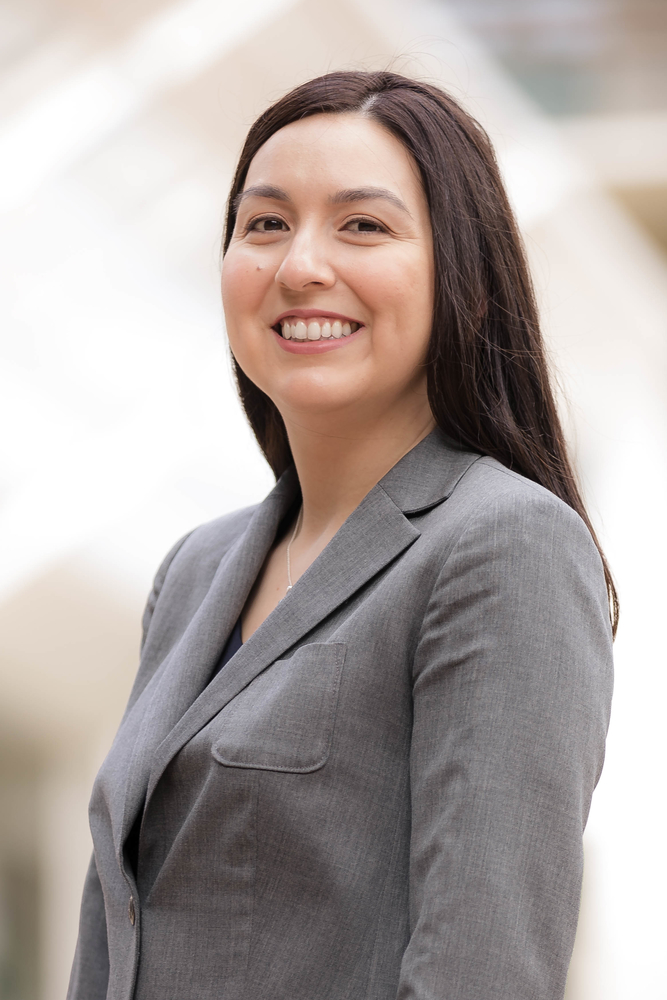 |
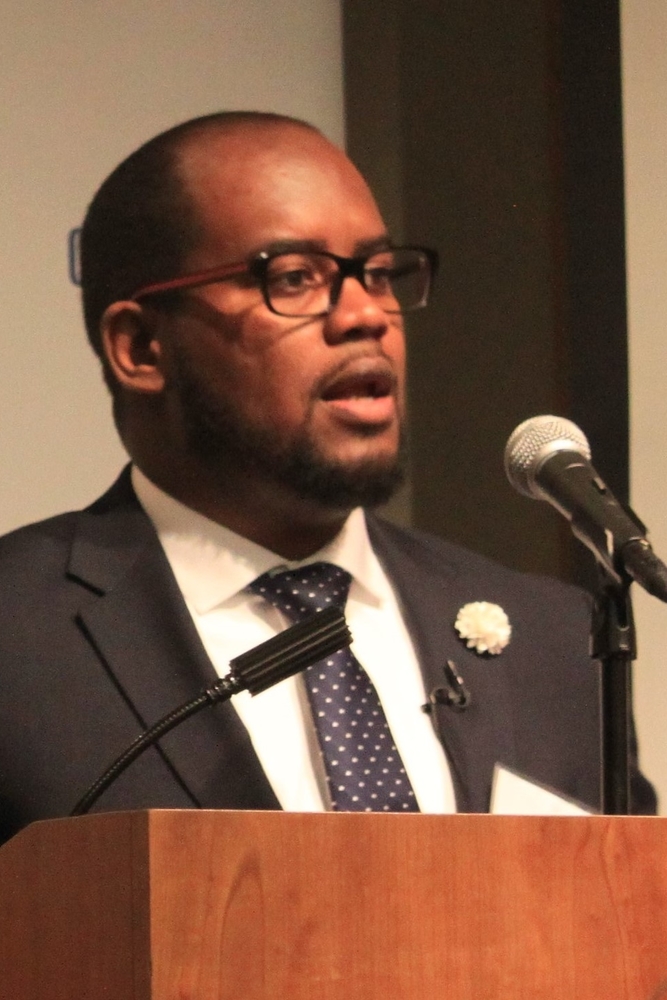 |
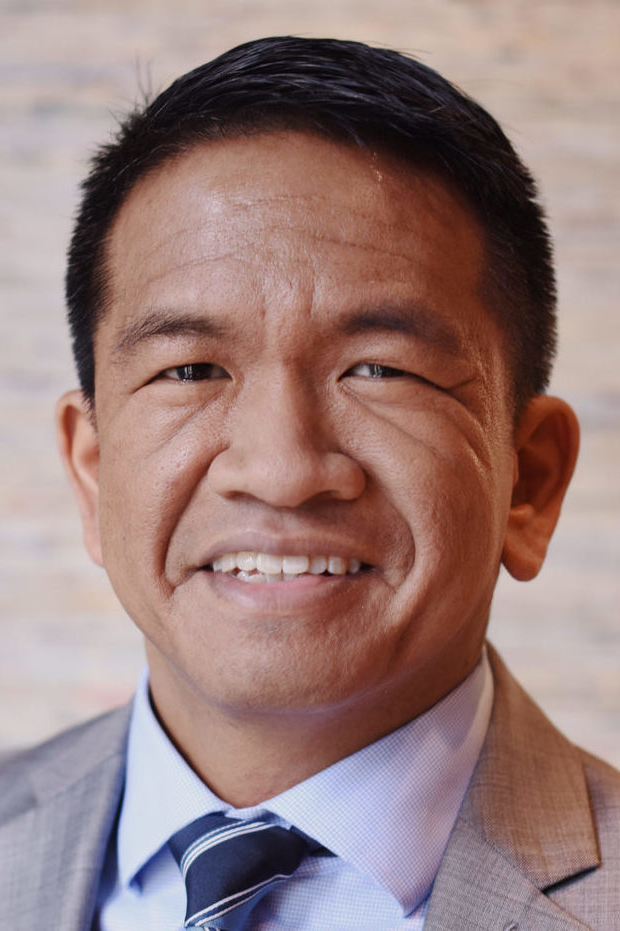 |
|
| Genevieve Carpio Assistant Professor at UCLA Department of Chicana/o Studies |
Charles Brown Adjunct Professor/Senior Research Specialist at Rutgers University |
Chris Pangilinan Head of Global Policy for Public Transportation at Uber |
Addressing Transportation Safety Needs Among Vulnerable Populations
More than 180 transportation policymakers, planners, and advocates gathered Oct. 20-22 for the 29th annual UCLA Lake Arrowhead Symposium — Routes to Opportunity: Connecting Transportation and Equity. This year’s event examined how transportation and land use approaches can advance policies and programs that center social equity and improve access to opportunity for people and communities.
The conference’s second day began with a session exploring the barriers vulnerable populations (e.g., women, people of color, LGBTQ, older adults, and people with disabilities) face when riding transit. The presenters discussed ways in which the transportation industry can address many of these challenges to improve access for these communities.
The session was moderated by Madeline Brozen, deputy director of the UCLA Lewis Center for Regional Policy Studies, and included presentations from Genevieve Carpio, assistant professor at the UCLA Department of Chicana/o Studies; Charles Brown, adjunct professor and senior research specialist at Rutgers University; and Chris Pangilinan, head of global policy for public transportation at Uber.
How historic injustices affect today’s mobility patterns
UCLA professor Carpio kicked off the session with an overview of how transportation construction and “place-making” have historically been racialized to exclude many populations. Past policies and laws — such as the Geary Act that prohibited Chinese people from coming to the United States, vagrancy laws that targeted specific populations like Japanese bicyclists, and immigration acts that ranked migrants by their perceived natural propensity for movement — have impacted present-day mobility access for these communities.
“If we truly acknowledge that the past is ever-present, then we can truly move to a more equitable future,” Carpio said. History can teach us how to address biases in transportation planning and reorient planning to be more inclusive. Rather than looking at external sources, Carpio said planners should look toward “homegrown solutions” and see what people are doing today to make transportation culturally and socially meaningful to them.
How safety, harassment, and policing shape mobility
Brown, Rutgers professor and self-proclaimed “street-level researcher,” followed up with a presentation of the difficulties black and brown communities face when using public transit. In particular, he explored how policing, racial profiling and a decreasing allocation of investments and resources affect the transportation choices made by these communities.
Brown shared highlights from 10 recent projects he’s worked on, including pedestrian safety in communities of concern (African Americans were 72 percent more likely to be struck and killed while walking) and a bikeshare feasibility project in Camden, New Jersey, where during the first week of implementation 278 of the 300 bikes were removed by residents not to steal, but rather for safekeeping — a phenomenon that wasn’t anticipated when this program was introduced into an environment of scarcity.
Brown suggested numerous equity actions that could remedy some of these discrepancies in mobility experiences, including prioritizing street and bikeway investments, and maintenance in communities of concern, ensure full and fair participation of low-income and minority communities in decision-making processes, map the correlations between crime and traffic violence data, and, most importantly, go to the streets and listen to the people. “The community is always the expert. Equity is not a desktop practice.”
Providing improved physical access to new and old mobility systems
Closing out the session, Pangilinan discussed physical access and the ways that the concept has evolved over time both in theory and in practice. Almost three decades since the passage of the Americans with Disabilities Act, subway accessibility in New York City is still problematic. Twenty-three percent of NY stations have elevators, but the opportunities can be even more limiting when riders must plan for a working elevator at the start and stop of their trip. Pangilinan was part of a 2017 campaign to make subways more ADA-accessible, and since then the MTA has pledged $5 billion for more elevators, plus a commitment to make the whole system fully accessible by 2040.
Now at Uber, Pangilinan is working to make the service more accessible, such as the use of a voiceover tool for people who are blind or have low vision, in-app features that allow phones to vibrate for those who are deaf and hard of hearing, location-sharing for people with cognitive disabilities, and the use of wheelchair-accessible vehicles.
In framing his conclusion, Pangilinan reiterated, “if we consider designing for people with disabilities, we often design a better system for all.”
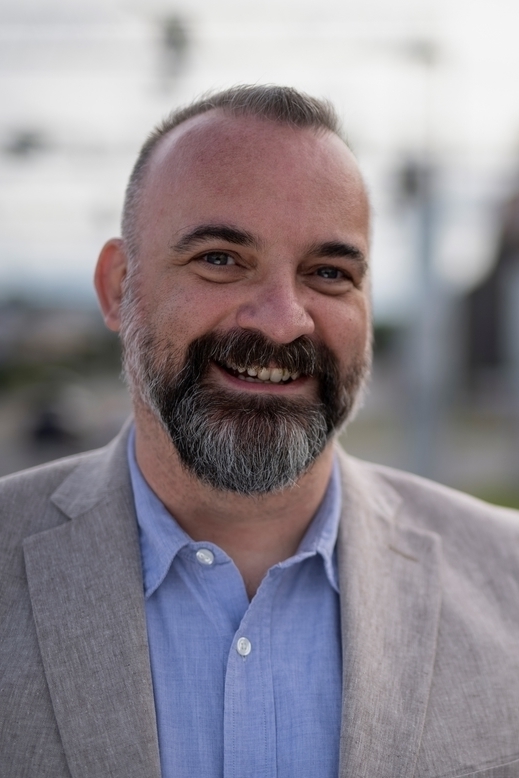 |
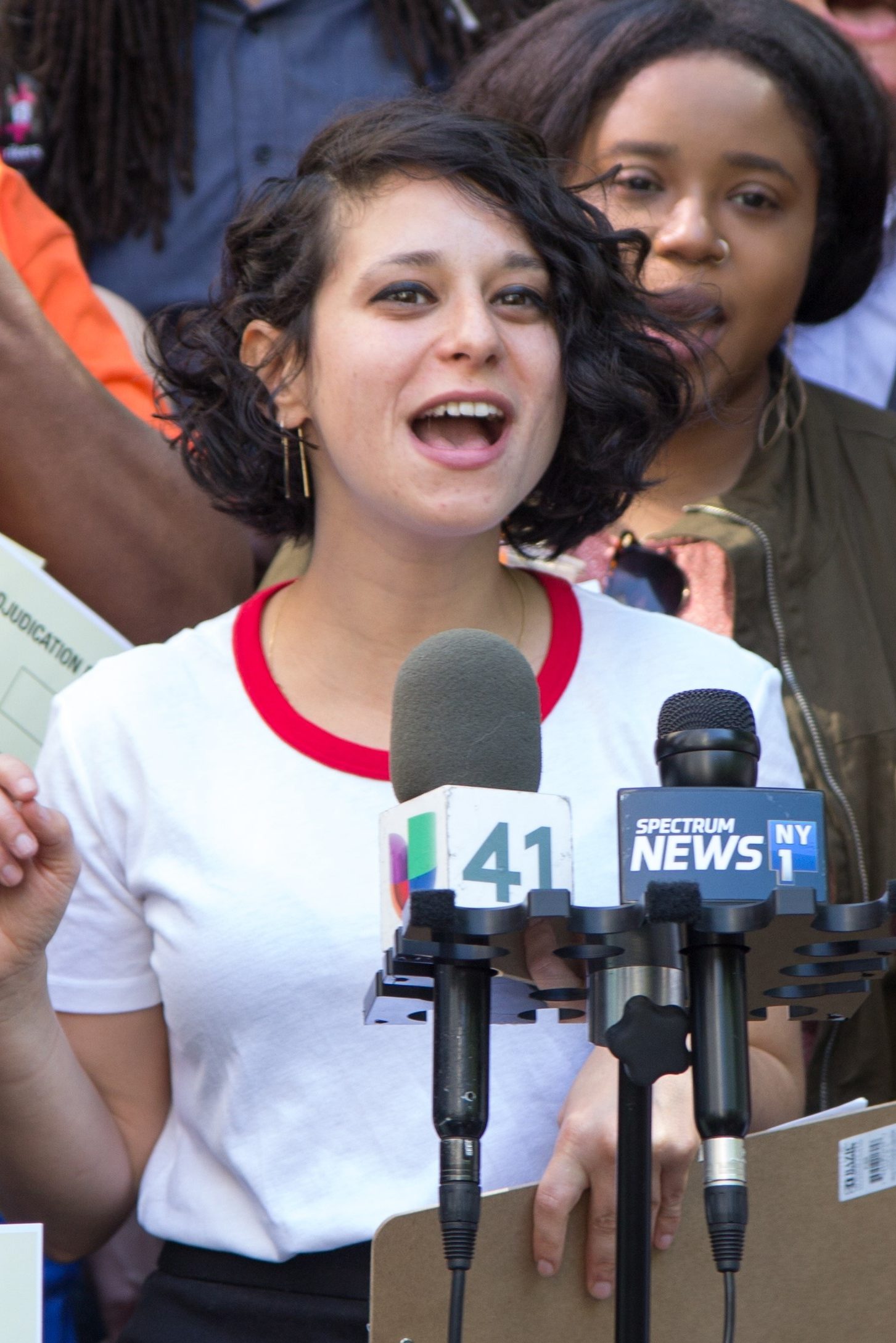 |
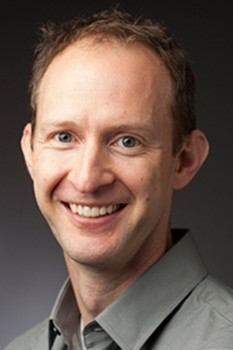 |
|
| Daniel Firth Global Lead, Congestion Pricing at WSP |
Rebecca Bailin Political Director at Riders Alliance |
Michael Manville Associate Professor at UCLA Luskin School of Public Affairs |
Who pays and who benefits? Equity and Congestion Pricing
More than 180 transportation policymakers, planners, and advocates gathered Oct. 20-22 for the 29th annual UCLA Lake Arrowhead Symposium — Routes to Opportunity: Connecting Transportation and Equity. This year’s event examined how transportation and land use approaches can advance policies and programs that center social equity and improve access to opportunity for people and communities.
Day two of the conference continued with a conversation about transportation finance, in particular how policymakers set prices and finance transportation services and infrastructure. The presenters explored how policies around transportation costs can impact disadvantaged communities.
This session was moderated by Tham Nguyen, senior director of LA Metro’s Office of Extraordinary Innovation, and included presentations from Daniel Firth, principal consultant at WSP; Rebecca Bailin, political director with New York City’s Riders Alliance; and Michael Manville, associate professor of urban planning at the UCLA Luskin School of Public Affairs.
Planning congestion pricing programs to achieve equitable outcomes
While congestion pricing remains a controversial issue, many cities across the world have successfully adopted it. In his presentation, Firth — who was involved in the congestion pricing programs in Stockholm, London and Vancouver — highlighted how cities have implemented these programs and the impact they’ve had on questions of income equity.
In particular, he explored how, after Stockholm implemented a pricing program, the research found that higher-income groups ultimately paid more, creating a high potential for redistributive policies like reduced transit fares. Research also found that middle-income segments changed their driving habits more. In calculating the costs and benefits of congestion pricing, Firth said policymakers should maximize time savings and environmental/public health benefits, while minimizing adaptation costs, like switching to transit.
Coalition building for congestion pricing and transit
The success of congestion pricing in many of these cities is sometimes due to the efforts of coalitions. In her presentation, Bailin discussed Riders Alliance and its success in building a coalition of community-based organizations and appealing to elected New York state officials for a fair, equitable path for funding New York City’s aging subway infrastructure. The Riders Alliance was able to build a path to victory by targeting state politicians and holding them accountable for the state of the MTA, and by highlighting the daily, lived experiences of transit riders on the system. Through this work, the Riders Alliance was able to position congestion pricing not just as a tool to fight traffic, but also as a key funding source for improving the reliability of the subway for riders. Ultimately, the coalition succeeded, and New York City’s congestion pricing program is set to be implemented in 2021 in central Manhattan.
Will congestion pricing harm low-income drivers?
In the final presentation of the session, UCLA professor Manville responded to a number of critiques of congestion pricing through an equity lens, highlighting how decision-makers can evaluate questions of fairness in their programs. Manville said congestion pricing was more a strategy for efficiency (traffic) than equity, but that it doesn’t have to exacerbate inequities and can be paired well with other policies to address them.
One of the criticisms of congestion pricing is that it is a burden on low-income drivers; however, currently, almost twice as many affluent drivers than poor drive during peak morning commute times, Manville said. The poor are also more likely to live near freeways and suffer the health consequences caused by pollution from congestion. Citing his recent research as an example, he explained congestion pricing’s potential ability to introduce fairness to the unfair status quo of free roads. Just as cities have existing programs to provide essential goods to those who cannot afford them, Manville noted, the same could be done for priced roadways.
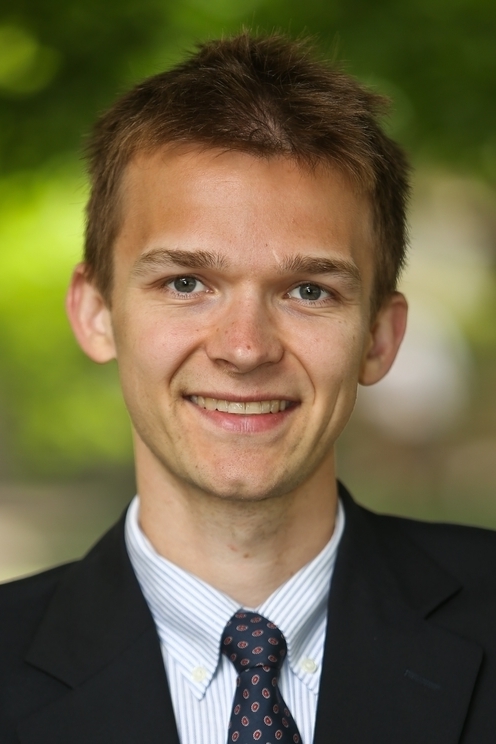 |
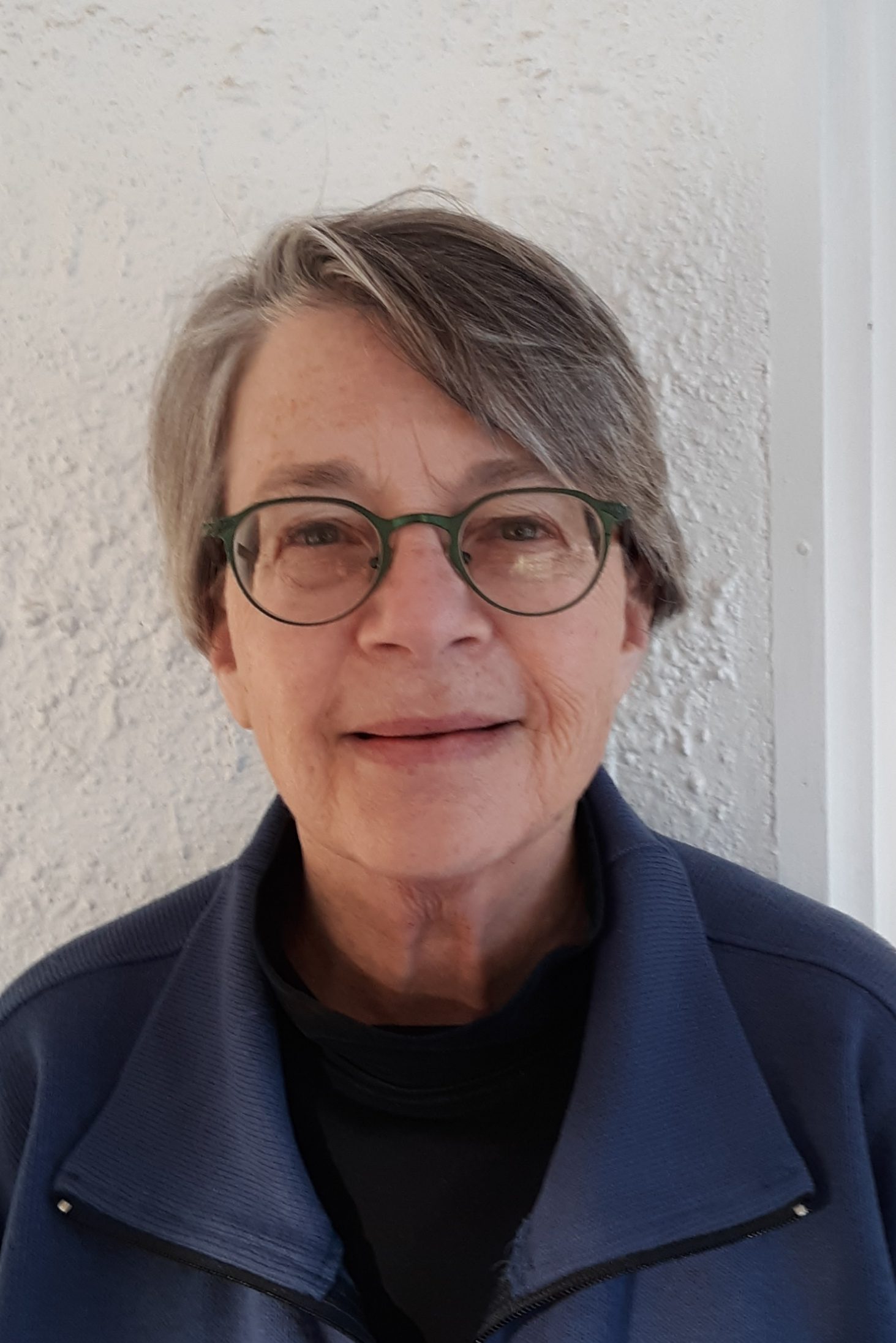 |
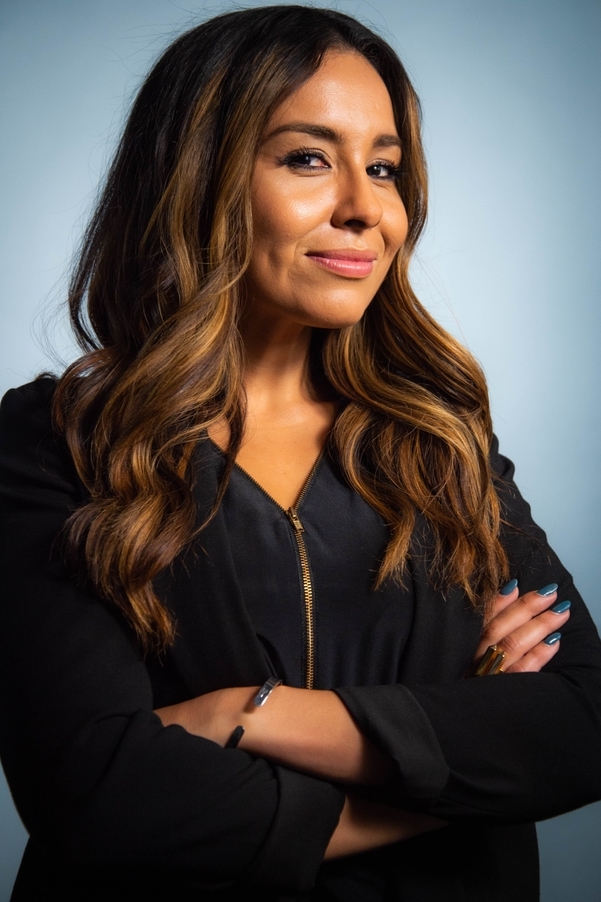 |
|
| Joseph W. Kane Senior Research Associate/Associate Fellow at Brookings Institution |
Pat Greenfield Senior Program Director at Transportation Learning Center |
Maria G. Meleandez Transportation School Manager at LA Metro |
Fostering the next generation of the transportation workforce
More than 180 transportation policymakers, planners, analysts, and advocates gathered Oct. 20-22 for the 29th annual UCLA Lake Arrowhead Symposium, Routes to Opportunity: Connecting Transportation and Equity. This year’s conference examined how transportation and land use approaches can advance policies and programs that center social equity and improve access to opportunity for people and communities.
This panel discussed the effect of major transportation public works projects on a region’s employment, and how and whether major infrastructure can create new opportunities for low-income workers.
The session was moderated by Stephanie Wiggins, CEO of Metrolink, and included presentations by Joe Kane, senior research associate at the Brookings Institution; Pat Greenfield, senior program director of workforce education at the Transportation Learning Center; and Maria Meleandez, Transportation School manager at LA Metro.
The state of the transportation jobs sector
The infrastructure construction sector, which accounts for 11 percent of all U.S. jobs, has long been a source of well-paying, stable jobs, but in recent years the workforce has dwindled. According to Kane, the sector’s workforce, which is predominantly in transportation and freight, is lacking younger workers: the median age of a bus operator is 53, 11 years older than the median American worker. In coming years, Kane predicted the sector will need to replace 3 million infrastructure workers with younger hires, as older ones retire or change jobs. He also emphasized the need for a new approach to infrastructure hiring and training, specifically one that recognizes and addresses the lack of diversity and broad age gaps in the sector.
Training front-line transit staff
Transit agencies are not excluded from the aging trend in the overall transportation workforce. In the next 10 years, agencies will have to hire and train 126 percent of today’s transit workforce. Greenfield explained how the nonprofit Transportation Learning Center’s Transit Core Competencies Curriculum (TC3) prepares younger workers with the technical training and transportation knowledge for careers in transit, creating programs that connect workers in general fields with their respective tracks in transit. Many younger workers do not know about opportunities within transit beyond the bus operators they interact with, Greenfield said. So one element is to train people in communities to connect young people to transit jobs, and to expose them to stories from workers who have worked their way up to become trainers.
Teaching the next generation
In Los Angeles County, Metro is getting a head start on training its next generation of workers, especially as Measure M projects create the need for hundreds of thousands of infrastructure jobs. Last year, in coordination with LA County and the SEED Foundation, the agency announced it will launch a STEM-focused transportation school called SEED LA to train the future LA transportation workforce. The school, which will be built in South LA, will serve about 400 students from grades 9 to 12 and will include college prep to offer a variety of post-graduation paths. Curricula will mix traditional STEM academics with transit-focused, hands-on programming. Meleandez explained that SEED LA is part of Metro’s broader youth initiative, called Metro E3 (Expose, Educate, and Employ), which has already driven educational and outreach programs aimed at connecting young people to transit skills and careers.
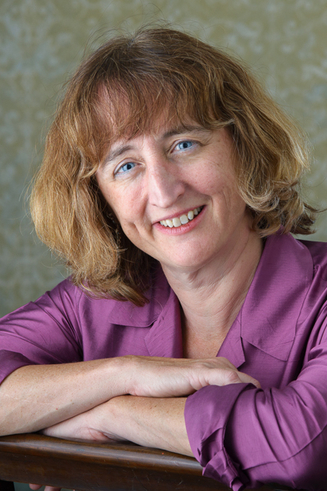 |
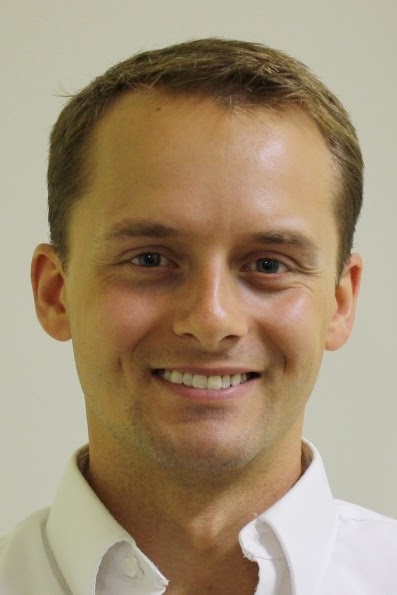 |
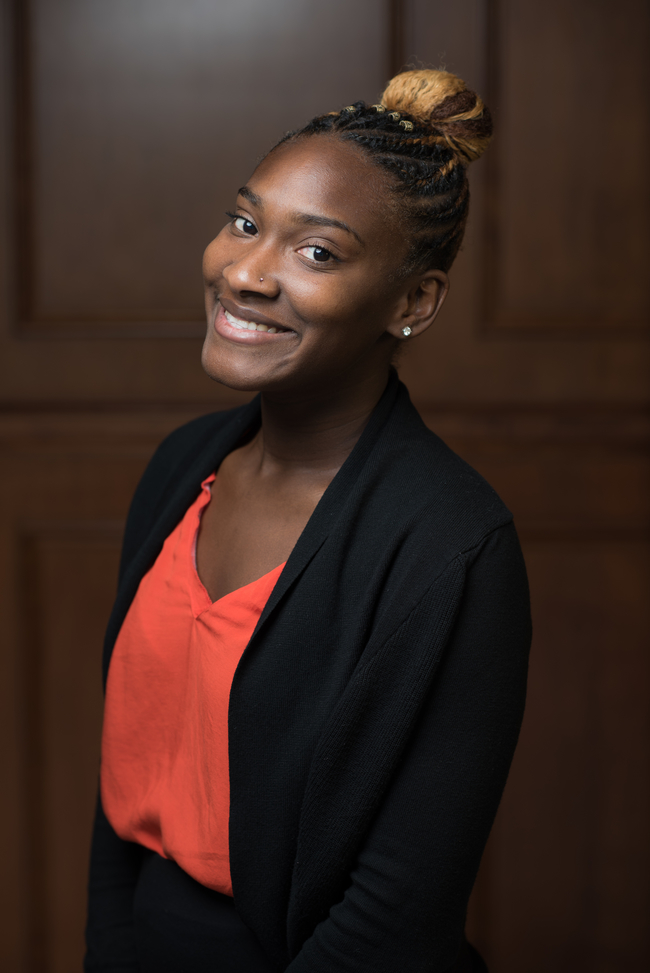 |
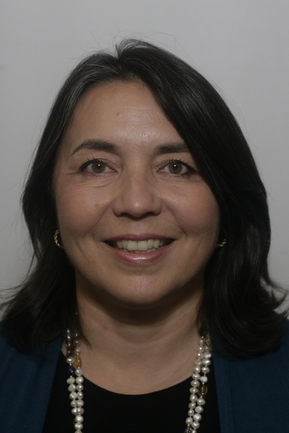 |
| Karen Chapple Professor at UC Berkeley |
John Hersey Senior Associate for Transit-Oriented Development at Denver Regional Transportation District |
Amari Foster Project Manager at Georgia STAND-UP |
Cynthia Strathmann Executive Director at SAJE |
Is transit-oriented development without displacement possible?
More than 180 transportation policymakers, planners, and advocates gathered Oct. 20-22 for the 29th annual UCLA Lake Arrowhead Symposium — Routes to Opportunity: Connecting Transportation and Equity. This year’s event examined how transportation and land use approaches can advance policies and programs that center social equity and improve access to opportunity for people and communities.
As new transit investments come to fruition, urban communities often express rising concerns over gentrification. The last session of Monday’s events explored this relationship and its impacts on low-income households.
The session was moderated by Trent Lethco, a principal and leader of Arup’s Americas Transport Consulting, and included presentations from Karen Chapple, professor of city and regional planning at UC Berkeley; John Hersey, senior associate for transit-oriented development at Denver RTD; Amari Foster, project manager with Georgia STAND-UP; and Cynthia Strathmann, executive director of SAJE (Strategic Actions for a Just Economy).
Understanding the relationship between gentrification and transit investments
Chapple kicked off the session with an overview of the legacy of urban renewal in traumatized neighborhoods, including the different forms of displacement from evictions to redlining and demolitions for safety reasons, to make way for new housing or to expand transit constructions.
However, the landscape is murkier when it comes to the relationship between gentrification displacement and transit. In a recent study, Chapple and colleagues found a strong relationship between transit and gentrification in the Bay Area, but less so in Los Angeles. There is a lack of evidence on displacement because of the limited timeframe and units of analysis. Displacement isn’t a one-time event, but rather a process that takes place across a regional scale, which makes it difficult to study, she said.
Connecting transit service to affordable development opportunities in Denver
In his presentation, Hersey explored how cities can create affordable housing particularly in transit-oriented neighborhoods where there are rapidly rising property values. In Metro Denver, 0.6 percent of the land area is within a half-mile of an RTD station. This accounted for 24 percent of all multi-family development and 32 percent of office development between 2005 and 2018.
Affordable housing is included in Denver’s equitable transit-oriented development program, which targets 60 percent of the area median income and the Denver Housing Authority incorporates anti-displacement strategies such as temporary housing for residents while new developments are built. Hersey said partnerships and financial support, including an expansion of its TOD fund, have benefited this program, but more is needed.
Preserving residents and expanding transit in Atlanta
Atlanta ranks worst in the nation for income inequality. As Foster noted during her presentation, in Atlanta, your neighborhood can impact public health and life expectancy ranges 13 years based on where one lives.
As Atlanta continues to see a boom in transit, organizations like the Transformation Alliance seek opportunities for collaboration with communities with the goal of anti-displacement. There, the equitable transit-oriented development issues center around jobs, housing choice, mobility, health, climate, arts and place. As in other places around the country, Atlanta faces challenges of translating and identifying community needs and addressing issues of race to keep equity at the center of all conversations.
Community engagement and transit-oriented communities in South LA
Closing the session, Strathmann discussed community engagement and the development of the People’s Plan in South LA, one of the most overcrowded areas in Los Angeles where the median household income is $25,243. As a coalition member of ACT-LA, they helped pass Measure JJJ that requires good jobs for local residents and affordable housing be included in developments over a certain size.
In partnering with UNIDAD (United Neighbors in Defense Against Displacement), SAJE also helped create the People’s Plan for displacement-free investment zones in South LA. It has advocated for the strongest affordable housing incentives, demolition protections to minimize the loss of rent-controlled homes, and a first-ever “no net loss” monitoring program. Other “wins” include support for local small business and street vendors, stronger protections against predatory lending and improved air quality standards.
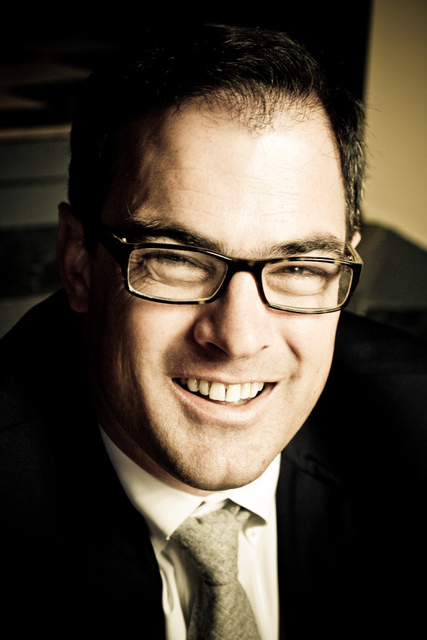 |
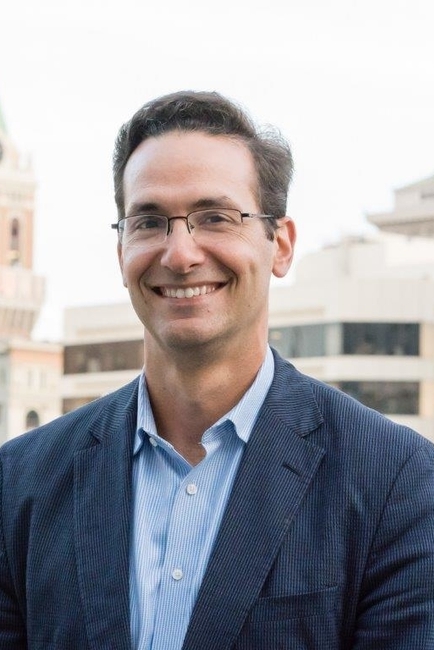 |
 |
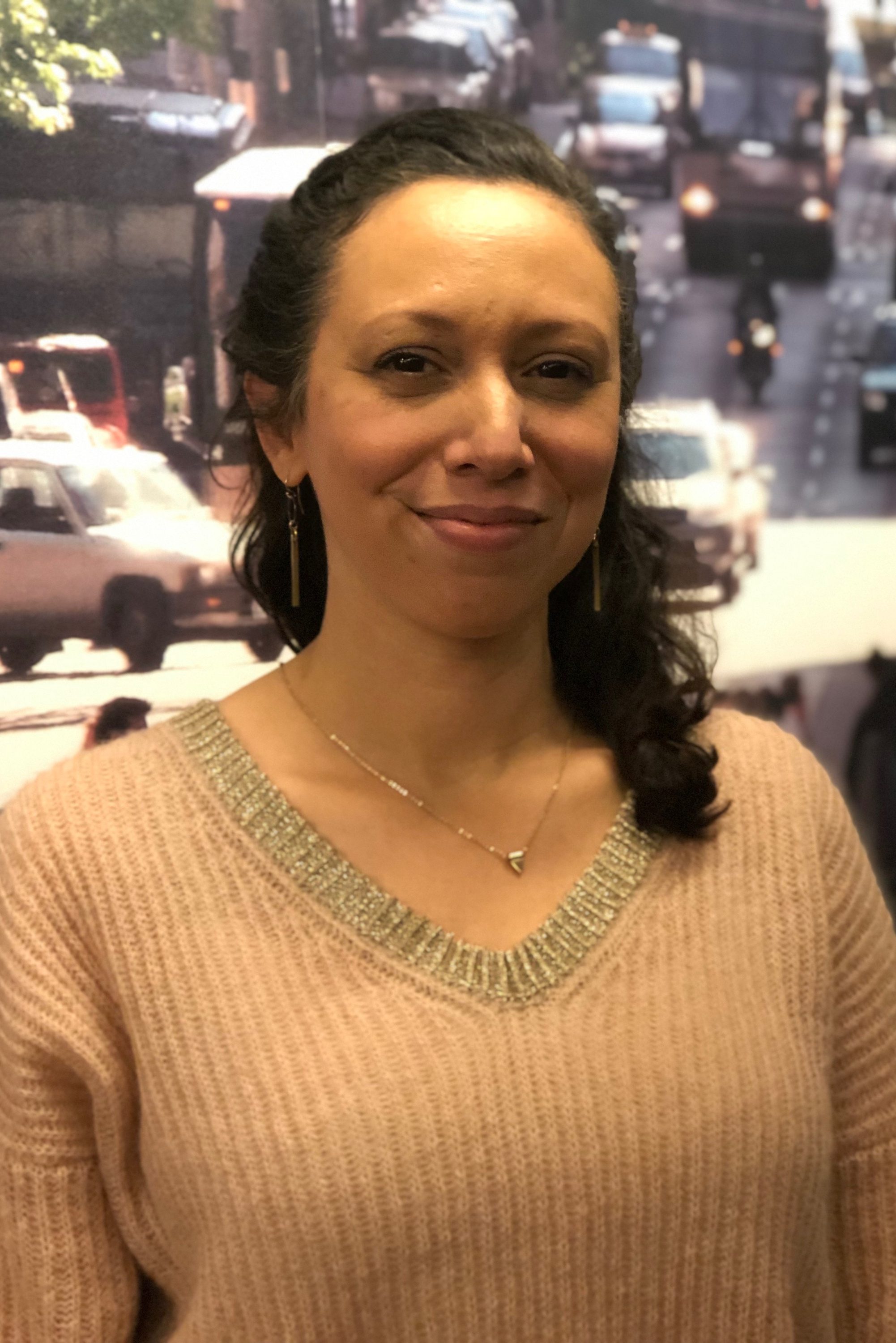 |
| Tom Knox Executive Director at Valley Clean Air Now |
Ryan Russo Director at Oakland Department of Transportation |
Steven Higashide Director of Research at Transit Center |
Naomi Doerner Transportation Equity Program Manager at Seattle Department of Transportation |
Finding Local Pathways for Transportation Equity
More than 180 transportation policymakers, planners, and advocates gathered Oct. 20-22 for the 29th annual UCLA Lake Arrowhead Symposium — Routes to Opportunity: Connecting Transportation and Equity. This year’s event examined how transportation and land use approaches can advance policies and programs that center social equity and improve access to opportunity for people and communities.
In the final session of the event, the presenters concluded by exploring how transit agencies across the country have implemented solutions to many of the transportation equity problems explored in the previous sessions.
The session was moderated by Francie Stefan, acting chief mobility officer and assistant director of planning and community development for the City of Santa Monica, and included presentations from Tom Knox, executive director, Valley Clean Air Now; Ryan Russo, director, Oakland Department of Transportation; Steven Higashide, director of research, TransitCenter; and Naomi Doerner, transportation equity program manager, Seattle Department of Transportation.
Access to clean cars and more in California’s Central Valley
Knox took the stage first and shared the results of the San Joaquin Valley Clean Air Now’s (CAN) recent programs. The area has some of the nation’s worst air quality. Some of the dirtiest cars in the state that account for about a third of total light-duty vehicle emissions are found in disadvantaged communities where low-income residents drive older cars that don’t pass smog tests. To combat this, a Saturday morning program for low-income drivers helps by providing vouchers for smog repair. Since the Tune In & Tune Up program was instituted, 75 percent of vouchers were redeemed and 80 percent of those redemptions resulted in smog certification.
Paving equity in the streets
In the next presentation, Russo outlined OakDOT’s prioritization of disadvantaged communities in its recent paving program. The department has centered its work around progressive policies that aim to recognize and address past injustices, such as redlining or how the building of BART and freeway expansions removed black and brown residents from their homes.
For its paving program, OakDot officials prioritized street conditions, population density and equity. The cost of a broken axle has a higher impact in low-income communities where a repair might mean forgoing rent, doctor’s visits or other bills. Russo and his team also engaged with the community to redesign intersections, walkways, bike medians and more to integrate with community needs.
Crafting a winning alliance for tactical bus improvements
In the next case study presentation, Higashide discussed the process of carrying out tactical transit lanes for bus improvements. Tactical lanes are usually a mile in length and erected using temporary materials, like cones. Often, the lanes themselves function as pilot projects for longer-term bus-only lanes and can therefore gather more representative input from riders. In the Boston area, one lane improved peak-hour travel by 20 to 25 percent and received overwhelming support from riders that it was made permanent a month after launching.
Higashide said success spurs success and now more dedicated bus lanes are coming to Boston. Other cities like Cincinnati, Washington, D.C., and Los Angeles are expanding or measuring the success of their tactical lanes. In LA, the lane opened as a mitigation for the closure of the Blue Line, but with travel time reductions of about 20 percent, Metro is recommending the pilot continue past the reopening of the light rail line in 2020.
Building internal leadership for transportation equity in Seattle
Doerner closed the session with an overview of Seattle’s Transportation Equity Program including its history, activities and recent projects. In Seattle, the community pushed for city- and department-wide efforts to increase equity, and the SDOT established its equity office in 2017.
Doerner said the department’s program aims to build community capacity and mobility by providing information, resources and safe, affordable and accessible sustainable transportation. Programming includes: providing free transit passes to people making less than 30% of the area median income, providing aging adults with reduced fair permits at some senior center sites, and launching a youth ambassador program to promote storytelling.
Select Photos from the Symposium
